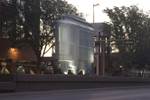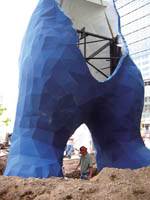Kinetic sculpture made possible with carbon fiber composites
Halo, an unusual wind-activated kinetic sculpture is realized with the help of Gurit (Newport, Isle of Wight, U.K.) and molder Innovation Composites (South Nowra, New South Wales, Australia)
An unusual wind-activated kinetic sculpture, designed by two of Australia’s preeminent public artists, Jennifer Turpin and Michaelie Crawford, was realized with the help of Gurit UK (Newport, Isle of Wight, U.K.) and molder Innovation Composites (South Nowra, New South Wales, Australia). The composite creation, dubbed Halo, is a giant tapered yellow ring, measuring 12m/39 ft in diameter. The ring is attached to a 6m/19.5-ft long silver arm, which, in turn, is mounted atop a 13m/42.2-ft tall silver pole. With an eccentric balance point, the ring tilts and turns in response to changes in wind speed, direction and gusts. The unpredictable movement provides a visually intriguing contrast to the stationary pole, especially when illuminated at night. Notably, the weight of the ring and arm is balanced on a ceramic bearing the size of a small glass marble.
The sculpture project was managed by structural engineers Partridge Event Engineering (St. Leonards, New South Wales, Australia). Gurit’s structural engineering team was called in to help turn the unique design into a tangible piece of public art for Central Park in Sydney, Australia. The artists’ design called for the ring to taper dramatically from its root to its far edge and to be as light as possible to maximize movement in the wind, yet appear to sit flat at rest. After the initial structural design concept was developed, Gurit engineers used advanced finite element analysis (FEA) to run a series of design optimizations with various fiber architectures. The FEA determined that to meet the weight and stiffness criteria and minimize deflection, a carbon fiber/epoxy composite was the only feasible material.
The plug and mold for the ring were made by mouldCAM (Tingalpa, Queensland, Australia), using Gurit T-Paste 70-2 machinable tooling paste. Then, the ring was hand laminated by Innovation Composites, using Gurit double-bias carbon/E-glass cloth and unidirectional carbon tape, wet out with Gurit’s Ampreg 22 epoxy resin. The ring’s supporting arm was designed and fabricated with a crescent-shaped cross-section (to better react to the wind) using Gurit SE 84 LV prepreg to lay up the arm and to maintain very tight tolerances where the part had to fit into metal end-brackets for attachment to the pole. The sculpture was installed in November 2012.
Related Content
-
Plant tour: Teijin Carbon America Inc., Greenwood, S.C., U.S.
In 2018, Teijin broke ground on a facility that is reportedly the largest capacity carbon fiber line currently in existence. The line has been fully functional for nearly two years and has plenty of room for expansion.
-
Plant tour: Albany Engineered Composites, Rochester, N.H., U.S.
Efficient, high-quality, well-controlled composites manufacturing at volume is the mantra for this 3D weaving specialist.
-
The lessons behind OceanGate
Carbon fiber composites faced much criticism in the wake of the OceanGate submersible accident. CW’s publisher Jeff Sloan explains that it’s not that simple.












